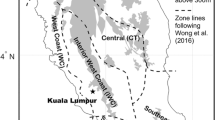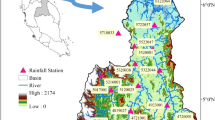Abstract
Current rainfall Intensity-Duration-Frequency (IDFs) curves generally were developed based on stationary extreme value assumption. However, climate change is expected to alter extreme rainfalls and invalidate the stationary assumption. So, it is crucial to develop future rainfall IDFs taking into account the impacts of climate change. Difficulty in preparing reliable rainfall time series with fine time step and capturing extremes for future climate scenarios has led to limited studies aimed at investigating the change of IDF curves due to climate change. In this paper, a robust stochastic rainfall model (NSRP) is employed to produce future rainfall IDFs for five stations across Karkheh and Karun basins in Iran. NSRP can generate long-term realistic rainfall series containing extremes. Moreover, it applies changes in different rainfall statistical characteristics, projected by GCMs, in the downscaling procedure. For each station, the model was calibrated using observed rainfalls series. Then, 3000-year daily rainfall series were generated, and historical IDFs were developed. Consequently, NSRP parameters were perturbed based on GCM projections. Then, 3000-year future rainfall series were generated, and future IDFs were developed. The climate change uncertainties were represented by employing two GCM (CanESM2 and HadGem2) and three emission scenarios (RCP2.6, RCP4.5, and RCP8.5). The results showed NSRP is able to reproduce observed extreme rainfalls in a wide range of time scales. Also, climate change will lead to a considerable increase in future extreme rainfall intensity in the study basins. As averages of all considered scenarios, rainfall intensities will increase between 22 and 206% in the future.







Similar content being viewed by others

References
Agilan V, Umamahesh N (2016) Is the covariate based non-stationary rainfall IDF curve capable of encompassing future rainfall changes? J Hydrol 541:1441–1455
Alam MS, Elshorbagy A (2015) Quantification of the climate change-induced variations in Intensity–Duration–Frequency curves in the Canadian Prairies. J Hydrol 527:990–1005
Ardeshirtanha K, Sharafati A (2020) Assessment of water supply dam failure risk: development of new stochastic failure modes and effects analysis. Water Resour Manag:1–15
Burton A, Kilsby CG, Fowler HJ, Cowpertwait P, O’connell P (2008) RainSim: a spatial–temporal stochastic rainfall modelling system. Environ Model Softw 23:1356–1369
Chen J, Brissette FP, Leconte R (2010) A daily stochastic weather generator for preserving low-frequency of climate variability. J Hydrol 388:480–490
Cheng L, AghaKouchak A (2014) Nonstationary precipitation intensity-duration-frequency curves for infrastructure design in a changing climate. Sci Rep 4:7093
Collins M et al. (2013) Long-term climate change: projections, commitments and irreversibility. In: Climate Change 2013-The Physical Science Basis: Contribution of Working Group I to the Fifth Assessment Report of the Intergovernmental Panel on Climate Change. Cambridge University Press, pp 1029-1136
Cowpertwait P, Kilsby C, O’Connell P (2002) A space-time Neyman-Scott model of rainfall: empirical analysis of extremes. Water Resour Res 38(6-1):6–14
Dubrovský M, Buchtele J, Žalud Z (2004) High-frequency and low-frequency variability in stochastic daily weather generator and its effect on agricultural and hydrologic modelling. Clim Chang 63:145–179
Elshorbagy A, Lindenas K, Azinfar H (2018) Risk-based quantification of the impact of climate change on storm water infrastructure. Water Science 32:102–114
Favre A-C, Musy A, Morgenthaler S (2004) Unbiased parameter estimation of the Neyman–Scott model for rainfall simulation with related confidence interval. J Hydrol 286:168–178
Holman I, Tascone D, Hess T (2009) A comparison of stochastic and deterministic downscaling methods for modelling potential groundwater recharge under climate change in East Anglia, UK: implications for groundwater resource management. Hydrogeol J 17:1629–1641
Hosseinzadehtalaei P, Tabari H, Willems P (2017) Uncertainty assessment for climate change impact on intense precipitation: how many model runs do we need? Int J Climatol 37:1105–1117
Khan MS, Coulibaly P, Dibike Y (2006) Uncertainty analysis of statistical downscaling methods. J Hydrol 319:357–382. https://doi.org/10.1016/j.jhydrol.2005.06.035
Khazaei MR, Zahabiyoun B, Saghafian B (2012) Assessment of climate change impact on floods using weather generator and continuous rainfall-runoff model International. J Climatol 32:1997–2006
Khazaei MR, Ahmadi S, Saghafian B, Zahabiyoun B (2013) A new daily weather generator to preserve extremes and low-frequency variability. Clim Chang 119:631–645
Khazaei MR, Zahabiyoun B, Hasirchian M (2020a) Comparison of IWG and SDSM weather generators for climate change impact assessment. Theoretical and Applied Climatology:1-12
Khazaei MR, Zahabiyoun B, Hasirchian M (2020b) A new method for improving the performance of weather generators in reproducing low-frequency variability and in downscaling. Int J Climatol 40:5154–5169. https://doi.org/10.1002/joc.6511
Kilsby CG, Jones PD, Burton A, Ford AC, Fowler HJ, Harpham C, James P, Smith A, Wilby RL (2007) A daily weather generator for use in climate change studies. Environ Model Softw 22:1705–1719
Ng JL, Aziz SA, Huang YF, Wayayok A, Rowshon M (2017) Stochastic modelling of seasonal and yearly rainfalls with low-frequency variability. Stoch Env Res Risk A 31:2215–2233
Ng JL, Aziz SA, Huang YF, Wayayok A, Rowshon M (2018) Generation of a stochastic precipitation model for the tropical climate. Theor Appl Climatol 133:489–509
Olsson J, Burlando P (2002) Reproduction of temporal scaling by a rectangular pulses rainfall model. Hydrol Process 16:611–630
Onof C, Chandler R, Kakou A, Northrop P, Wheater H, Isham V (2000) Rainfall modelling using Poisson-cluster processes: a review of developments. Stoch Env Res Risk A 14:384–411
Peck A, Prodanovic P, Simonovic SP (2012) Rainfall intensity duration frequency curves under climate change: city of London, Ontario, Canada. Can Water Resour J Revue 37:177–189
Pourtouiserkani A (2014) Investigating climate change impact on extreme rainfall events (case study: Chenar-Rahdar Basin, Fars, Iran). Scientia Iranica 21:525–533
Richter G, Semenov M (2005) Modelling impacts of climate change on wheat yields in England and Wales: assessing drought risks. Agric Syst 84:77–97
Sanso B, Guenni L (1999) A stochastic model for tropical rainfall at a single location. J Hydrol 214:64–73
Semenov MA (2008) Simulation of extreme weather events by a stochastic weather generator. Clim Res 35:203–212
Semenov MA, Stratonovitch P (2010) Use of multi-model ensembles from global climate models for assessment of climate change impacts. Clim Res 41:1–14
Semenov MA, Brooks RJ, Barrow EM, Richardson CW (1998) Comparison of the WGEN and LARS-WG stochastic weather generators for diverse climates. Clim Res 10:95–107
Sharafati A, Azamathulla H (2018) Assessment of dam overtopping reliability using SUFI based overtopping threshold curve. Water Resour Manag 32:2369–2383
Sharafati A, Pezeshki E (2020) A strategy to assess the uncertainty of a climate change impact on extreme hydrological events in the semi-arid Dehbar catchment in Iran. Theor Appl Climatol 139:389–402. https://doi.org/10.1007/S00704-019-02979-6
Sharafati A, Pezeshki E, Shahid S, Motta D (2020a) Quantification and uncertainty of the impact of climate change on river discharge and sediment yield in the Dehbar river basin in Iran. J Soils Sediments 20:2977–2996
Sharafati A, Yaseen ZM, Pezeshki E (2020b) Strategic assessment of dam overtopping reliability using a stochastic process approach. J Hydrol Eng 25:04020029
Srikanthan R, McMahon T (2001) Stochastic generation of annual, monthly and daily climate data: a review. Hydrol Earth Syst Sci 5:653–670
Tfwala C, Van Rensburg L, Schall R, Mosia S, Dlamini P (2017) Precipitation intensity-duration-frequency curves and their uncertainties for Ghaap plateau. Clim Risk Manag 16:1–9
Wilby RL, Dawson CW, Barrow EM (2002) SDSM—a decision support tool for the assessment of regional climate change impacts. Environ Model Softw 17:145–157
Acknowledgements
The NSRP model used in this paper is adopted from the RainSim V3 model (Burton et al., 2008). The author of this paper is grateful for the provision of the RainSim V3 model by Burton, A., Kilsby, C.G., Fowler, H.J., Cowpertwait, P.S.P., O’Connell, P.E. Also, the author would like to acknowledge the data providers.
Author information
Authors and Affiliations
Contributions
M.R. Khazaei designed the research, analysis the data, and wrote the paper.
Corresponding author
Ethics declarations
Conflict of interest
The author declares no conflict of interest.
Additional information
Publisher’s note
Springer Nature remains neutral with regard to jurisdictional claims in published maps and institutional affiliations.
Rights and permissions
About this article
Cite this article
Khazaei, M.R. A robust method to develop future rainfall IDF curves under climate change condition in two major basins of Iran. Theor Appl Climatol 144, 179–190 (2021). https://doi.org/10.1007/s00704-021-03540-0
Received:
Accepted:
Published:
Issue Date:
DOI: https://doi.org/10.1007/s00704-021-03540-0



